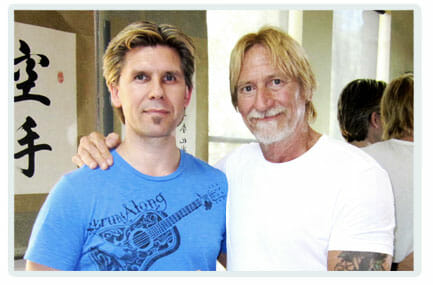You thought it was difficult to find a good tai chi teacher? Try finding a good qi gong teacher. Qigong is an energy art that can dramatically improve health, concentration and well-being. It can be undertaken by people of any age and with any physical limitation. Learning qi gong on your own is definitely possible, but there are some ways you need to practice and some things you need to consider before choosing a routine in order for you to get the huge health benefits that everyone is talking about. Here is where the hard part comes in:
Anyone can learn qigong without a teacher at home as long as they find instruction that includes:
- Expert, experienced instructors
- A routine that is taught in segments and built upon, not all at once
- Written or video explanations
- A way to ask the instructor questions
- Great explanation of the movements with video examples from different angles
Great progress usually demands 1) a great teacher and 2) an explanation of what progress looks and feels like so that we have a tangible sense of what changes are taking place. The best program that I have found to date is the Good Morning – Good Evening Qi Gong Set.
I found out about this course while researching ways to improve chi development without needing a trip to China. I attended two seminars that year that were pretty good. However, the instruction bordered on mysticism and the suggested exercises were not practical. When I found this course, my first impression of the website and description was that it promised a lot. How could I get more out of an online course than I could get from two in-person seminars?
But ask yourself: if you wanted to learn qi gong at home, what would you need?
A. Expert Instruction

You would have to be taught by someone with extensive experience. Someone who has had exposure to qi gong across the different periods of life because our energy is different at different ages, someone who has testimonials, someone who has taught at a high level, and has some sort down-to earth writing so that we are not left off in esoteric lala-land when we are trying to understand why and how qi gong works.
When I tell you that Tristan Truscott and Peter Ragnar teamed up to create this Qi Gong set you should be floored. A course by either one of them brings dozens of years of experience in marital arts and internal arts. Not to mention achievements, awards, and publications. Now put the two of them together to create a course and you have some of the best material available in the west.
B. Incremental Instruction: a.k.a. Why So Many People Fail at Qi Gong!
I love Qi Gong and can’t explain in words how it has helped me heal, excel in my job, recover from stressful times, travel fatigue, you name it. Yet, I am so sad because it is almost doomed to fail in the west. Why? Because the instruction we typically have access to is watered down or too short. Qi Gong takes time. It is like charging your cell phone. You can’t plug it in and hit 100%. You would fry your phone. No one and I mean NO ONE can learn qi gong in a weekend. Learning move-by-move is the only way how to learn qigong, building energy as you build up to the full set. Good Morning – Good Evening Qi Gong is taught incrementally across 4-weeks so you can build up your energy and learn incrementally.
C. Testimonials
I run Tai Chi Basics and aside from everything I do and dabble in, I do this set nearly every day. This is the set I instruct when people are injured or sick and the traditional health system has failed them. I want to support the efforts of people who are working to bring great information to the west and this is some of the best available. Aside from me, check out what people have to say on their own site.
Let’s take a constructive look at the course
The Minuses

- It is an online course without a lot of written material. Many of you are saying: “that’s a minus?” But some readers prefer written notes and when I teach qigong they ask me to write everything down. Typically writing or taking notes helps with the learning process so I don’t think it is necessarily a bad thing. This course more than makes up for it with the information provided in verbal and video instruction.
- The price is more than some other courses out there but I don’t know of anyone else who has this level of instruction and this high of success rate. Secondly, it’s less than half the cost of a live workshop and most tai chi or qigong classes are going for $40-$90/month. So this is a fraction of that. Plus there is a money-back guarantee.
- It is a standing routine. If you have fibromyalgia or difficulty standing for more than 8-10 minutes, you may want to find a sitting or laying course.
The Pluses

- The instruction is top-notch and both authors have an incredible level of experience.
- The video segments are professional and easy to follow.
- You need less than 10 minutes per day.
- The course is built into 4 parts designed to be learned in about one month.
- You learn a new segment each week to add on to the prior weeks segment as your power builds. This is by far the best way to learn qigong.
- If you are new to qi gong it is perfect. If you have been practicing for awhile it is also perfect.
- You can build your knowledge and energy to a level that you can effectively teach. If you have a dream of teaching qi gong, they have another course to help you do that too.
Who should buy this course?
If you want to seriously learn qigong, are interested in improving your health, or have a desire to develop the internal side of your tai chi, yoga, or meditation practice, then this is a great find. Check it out here: Good Morning – Good Evening Qi Gong
When you learn qigong at home, what kind of progress can you expect?
I want to share a little bit from my experience over the years both in terms of my own development and what I see from students who want to learn qigong. I wish that I had a roadmap when I began which probably would have helped me progress faster.
What it’s like when you begin to learn qigong: At the beginning it is really exciting because it is something new! And, you are looking forward to the benefits. It is also frustrating because you really don’t know what you are doing and you don’t see many results. Development is slow, and possibly not recognizable when you begin to learn qigong because:
- Your movements are not correct yet.
- You have to think about the moves and sequence so much that you can’t concentrate on the breathing and internal state which are necessary to build and feel chi (the energy).
- It takes a while to build your energy to the level to where you can feel it.
Tip for Qigong Beginners: Short daily practice makes for quicker progress because you need to memorize the movements and build energy enough to feel it. Relax ALL the muscles in the body to promote better blood flow. If you find yourself flexing you are constricting blood and energy flow. Check in before and after your set to see how awake you feel, how focused you are thinking, and what your mood is. Improvement isn’t dramatic but change is definitely happening.
The novice phase when you learn qigong: After you have memorized the sequence and have a few weeks of practice under your belt, the benefits of qigong start to be apparent. Basically, you’ve put your time in so now you are free to concentrate on the stuff to builds health and energy – breathing, posture, a calm mind. This can be a really long phase lasting several months to a year. For some of us, this is enough! And it’s everything we were looking for. For others of us, we are shocked at what we are feeling and are really interested in what else is possible. Here’s what to expect and look for:
- Most people feel “chi” in their palms first. It is different for everyone but is often described as a change in temperature, air blowing across their palms, or a wave passing over their palms. It is not a strong sensation and is not something you can control or is always present, a.k.a frustrating!
- Your body grows warm by the end of the qigong set.
- You can double or triple the length of your breath.
- For morning qigong routines, you are immediately warm, stretched, focused, and awake after the set. On days you don’t do qigong, this may not occur until after your shower, coffee, and commute.
As one starts to feel chi it is so so subtle and the mind easily ignores it or makes up an explanation for the new sensation. The diligent practitioner starts to feel more and more but who do they bounce their experiences off of without sounding like a lunatic? What do they do with those sensations and what is the next step? As an example from my early development:
I was blown away when I started sensing chi in my hands. I worked for months trying to improve this sensation and make it stronger. However, the harder I tried, the weaker it became. Flash forward one year to a Tai Chi workshop where I got to share my experience during a private lesson and seek advice. It was translated to me that the sensation in the hands was like a car’s exhaust. That heat in my hands was the natural overflow of abundant energy in my center. By increasing my body’s chi, the chi in my hands would increase as a beneficial side effect. By focusing on my hands, I was not adding to the source. That simple conversation changed the course of my development and moved me on to the next stage but I had not progressed for a year.
Tip for Qigong Novices: The feeling in your hands or forehead is lovely but it is the result of your hard work not the goal. Keep focusing on your breathing, upright posture, and keeping the mind as empty as possible. The entire aim is to build energy so that it is stronger and present more often. Do not forget to smile or at least relax the face. Sometimes when I teach qigong I have to laugh because some students have their face bunched up because they are concentrating and “trying” so hard. They look like they want to fight me! Relax your face!
The intermediate phase of learning qi gong: It gets tough here guys because the progress is incredible but it is not like you get hit with lightening or something. I hit this phase twice and abandoned practice because I felt I hit a ceiling. It took a conversation in China with a venerated teacher to comprehend a bit of my foolishness and see what I was supposed to be doing. In the intermediate phase many practitioners can:
- Actively feel and possibly increase the sensation in the hands.
- Feel energy throughout the whole body. A way to describe this is to inhale, then hold your breath and keep trying to inhale by imagining that you are inhaling with all of your skin. It’s not exactly a sense of energy but more a feeling of connectedness throughout your body which enables you to feel your entire body all at once.
So what should you be doing while learning qigong in the intermediate phase that I was not doing? You should be trying to extend the benefits of your practice to your entire life. Sounds hippie-ish, right? Let me give you some concrete examples:
- In bad emotional situations, you can breath like you do during the qigong set and return to normal. Such as; in an argument with your partner, talking to a frustrating co-worker, or getting cut off in traffic. All of these situations cause a rise in blood pressure and body temperature and a quickening of the pulse. You can bring these all back down immediately instead of stewing in it.
- You can avoid or reduce the number of major sicknesses you experience. This one is hard to explain but each day you spend 8-10 minutes experiencing what “great” is. When your energy is low or when your thinking is foggy it presents as such a stark contrast. When I do qigong and still feel like dooky afterwards, I know that something is not quite right. It is an alarm bell telling me to sleep in, take a break, eat better, take some vitamin C, or maybe hydrate. This way I head off most bugs or allergies rather than get surprised and have to recover from them.
Tip for Qigong Intermediates: Keep practicing and spread the benefits of your wellness to other areas of your life. The greatest advice I can give you is to use the first few minutes after your set to plan your day. You will be thinking clearly and choosing activities that are really important without the fear-thinking or negative-thinking that may have you avoiding what you know you need to do. If you do not meditate, consider learning a sitting meditation set like the Micro-Cosmic Orbit because at this point you will be able to experience some of the internal development they teach.
How does an advanced practitioner continue to learn qigong? My friends, we have hit the end of my current journey but I can share what I am experiencing and what top experts (Qigong medical practitioners) say is the next level. At the point that your energy is consistent and strong, you have the ability to positively affect others.
This sounds nuts on one hand but on the other hand we all know people who “radiate” a sense of wellbeing that makes us want to be around them. Parents and grandparents are one example whose presence is strong due to the love and connection. But what about strangers? Can we get there? It’s clear to me at this point we can. On the early end, it’s being singularly present for someone in a single conversation. It’s inflating a meeting room with a sense of calmness so that everything stays on track. In discussions with doctors at a Chinese medical academy in my town, they shared it is healing others with your energy. Past that, the doctors shared that it is drawing from a “greater energy source” to heal others so that you personally don’t become depleted.
Wherever you are with your health and development, hopefully you see that the best way to learn qigong might be on your own and the best place to learn qigong might be at home! Up past where most of us culturally would have conceived of as even being possible before the science arrived to back it up. Luckily we are at a place in time where technology makes it accessible and enables knowledgeable teachers to share. This routine is a good way to learn qigong or improve your practice: Good Morning – Good Evening Qi Gong.



